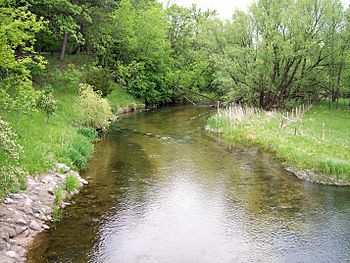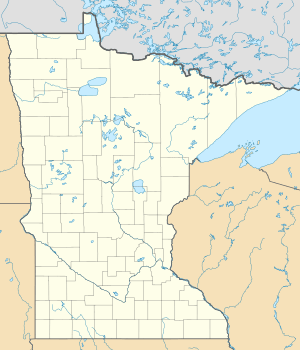Fish Hook River facts for kids
Quick facts for kids Fish Hook River |
|
|---|---|

The Fish Hook River in Park Rapids in 2007
|
|
|
Location of the mouth of the Fish Hook River
|
|
| Country | United States |
| State | Minnesota |
| Physical characteristics | |
| Main source | Fish Hook River Reservoir Park Rapids, Hubbard County 1,424 ft (434 m) 46°55′10″N 95°03′10″W / 46.91944°N 95.05278°W |
| River mouth | Shell River Hubbard Township, Hubbard County 1,362 ft (415 m) 46°49′49″N 95°01′55″W / 46.83028°N 95.03194°W |
| Length | 8.54 mi (13.74 km) |
| Basin features | |
| Tributaries |
|
The Fish Hook River is a small river, about 9 miles (14 km) long, in north-central Minnesota, United States. It's a tributary, meaning it flows into a larger river, which in this case is the Shell River. The Fish Hook River starts from Fish Hook Lake. This lake also collects water from two smaller streams called the Portage River and the Potato River.
The Fish Hook River is part of a much bigger watershed that eventually leads to the mighty Mississippi River. This means all the water from the Fish Hook River, through the Shell and Crow Wing rivers, ends up in the Mississippi. The river flows entirely within Hubbard County. Its wider watershed, the area that drains into it, also reaches into Becker County.
The river's name comes from the Ojibwe word Pugidabani. This word means "fish hook," which is why the river and Fish Hook Lake share this unique name.
Where Does the Fish Hook River Flow?
The Fish Hook River is thought to begin in the city of Park Rapids. Here, a dam creates the 2-mile-long (3 km) Fish Hook River Reservoir. This reservoir was built a long time ago to help produce hydropower (electricity from water) where the river used to have fast-flowing rapids.
From Park Rapids, the Fish Hook River flows towards the south-southeast. It passes through several areas like Todd, Straight River, and Hubbard townships. Along its journey, another river, the Straight River, joins it from the west. Finally, the Fish Hook River flows into the Shell River from the north in Hubbard Township.
How the River Gets Its Water
The Fish Hook River Reservoir gets its water from Fish Hook Lake. This lake is like a collection point for the river's northern watershed. The Portage River flows a short distance from Portage Lake to Fish Hook Lake. Similarly, the Potato River flows from Potato Lake into Fish Hook Lake. Potato Lake itself gets water from Hay Creek, which drains an area full of lakes in northeastern Becker County.
Nature and Wildlife Around the River
The Fish Hook River flows through a special natural area called the Northern Lakes and Forests ecoregion. This region is known for its beautiful conifer (like pine trees) and hardwood (like oak trees) forests. These forests grow on flat and gently rolling lands, which were shaped by ancient glaciers. These lands are called till plains and outwash plains.
The river is home to many different kinds of fish. The most common fish are suckers. But if you're lucky, you might also find popular fish like walleye and northern pike swimming in its waters.


